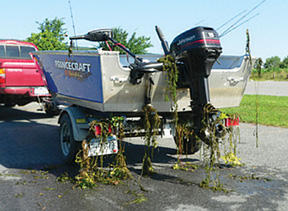The Alaska Department of Environmental Conservation is considering a state sought permit to apply an herbicide to 3 Fairbanks area water bodies infested with the invasive plant Elodea. Floridone has proven successful at battling back the aquatic weed known to choke out fresh waters.

The interior waters targeted for floridone application are Chena Lakes and Slough in North Pole, and Tochaket Slough north of Nenana. Department of Environmental Conservation Pesticide Control program director Karin Hendrickson said the herbicide has been successfully employed against similar Elodea infestations in Anchorage, Kenai and Cordova area waters.
”It’s an herbicide that basically works by preventing plants from photosynthesizing,” Hendrickson said.
Hendrickson said the main risk is killing off non target native plants.
”You wanna make sure that it’s applied carefully with the mind to that,” Hendrickson said. “It’s pretty widely studied in terms of any impact on other animals or humans or drinking water.”
Hendrickson said a risk assessment will be conducted specific to the herbicide use permit requested by the Department of Natural Resources.
”The ultimate goal is for state-wide eradication of Elodea,” Hendrickson said.
DNR invasive plant coordinator Heather Stuart said it’s suspected that Elodea came to Alaska as an aquarium plant. Stuart said the Elodea spreads easily as small bits of the plant can re-root after being accidently transported on boats, float planes, fishing and other water sports gear.
“If we don’t deal with it on a state-wide level, then there’s always that risk of having a water body that hasn’t been dealt with elodea in it, re-infesting an area that has already been treated,” Stuart said.
Aditi Shenoy is with the Fairbanks Soil and Water Conservation District, which has been wrestling with the local elodea infestation for a decade.
“A fragment of plants can start a new population,” Shenoy said. ”[We’ve] assessed a number of different alternatives for controlling elodea. Mechanical control using a suction dredge combined with raking.”
The harvesting technique proved unsuccessful against Elodea and the focus shifted to herbicide. Depending on the DEC risk assessment and permit, Shenoy said application of floridone could occur as early as this summer, noting there’s some urgency given the threat posed by Elodea.
“It could ruin fish habitats, which is really important for salmon and grayling rearing and spawning,”” Shenoy said. Also, if it gets into float planes, it creates really hazardous conditions for float plane operation.”
Shenoy said she’s applying for grants to help fund the project. The cost of floridone to treat Fairbanks area waters is estimated at close to a million dollars. Federal agencies like the U.S. Fish and Wildlife Service help fund Alaska Elodea eradication projects.
Dan Bross is a reporter at KUAC in Fairbanks.




